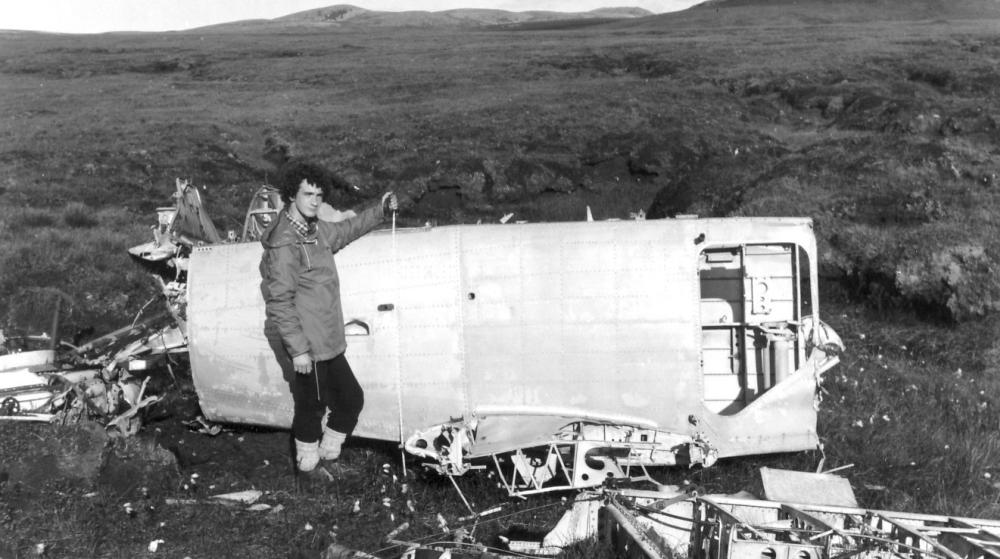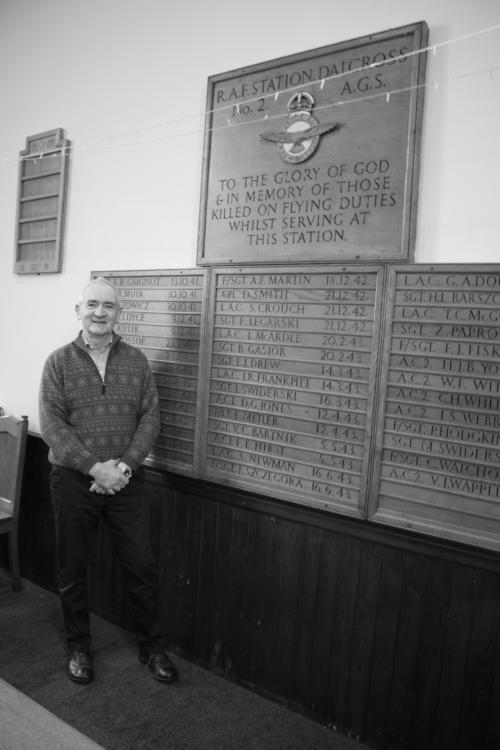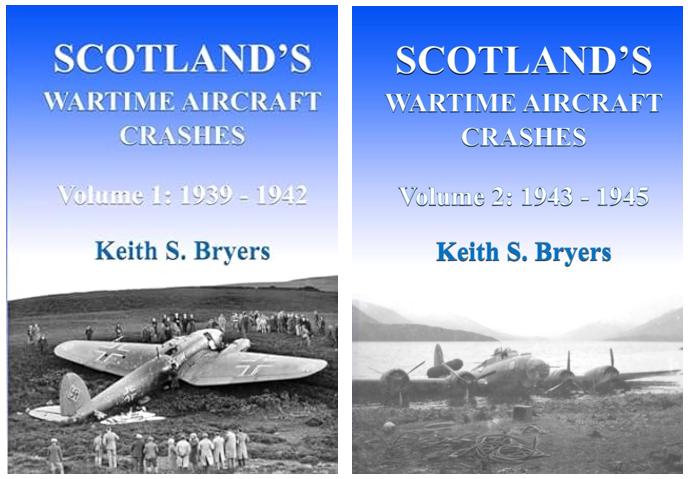4,500 crashes in Scotland on more than 700 pages
During the Second World War Scotland was a key location for many of the Allies’ defensive and offensive activities. It was also important for the training of aircrew and maintaining air and sea lines of communication with Allied nations. Scotland’s ports, factories and cities were important targets for the Luftwaffe, while adjacent seas had to be traversed by German capital ships and U-boats seeking to interdict Allied trade convoys and warships. These activities came at a heavy price by way of lives lost and aircraft destroyed in crashes not just on airfields but on low and high ground and in the seas around Scotland, the rest of the British Isles and further afield. Keith Bryers wrote a book about this subject, Scotland's Wartime Aircraft Crashes, that has now been published by Aviation Books Ltd[/url]. We asked the writer some questions about his book by e-mail.
 Photo taken in 1974 of the author with the forward fuselage of Albacore N4172. It was removed a few years later, along with the rest of the wreck, for the Fleet Air Arm Museum's reproduction of an Albacore, using parts from several wrecks. It is now on display at the museum in Yeovilton, Somerset, England. Source: Keith Bryers
Photo taken in 1974 of the author with the forward fuselage of Albacore N4172. It was removed a few years later, along with the rest of the wreck, for the Fleet Air Arm Museum's reproduction of an Albacore, using parts from several wrecks. It is now on display at the museum in Yeovilton, Somerset, England. Source: Keith Bryers
When did you start researching World War Two Aircraft Crashes in Scotland and where does your interest in this subject come from?
When I was about 16 years old, in the early 1970s. My initial interest was sparked by a memorial in a local church to airmen who had died during the war while flying with 2 Air Gunners School, based at RAF Dalcross, which is now Inverness Airport. I found that nothing was known locally about the circumstances of the mens’ deaths, so I started to make my own enquiries.
How did you get your information?
This was in the early/mid-1970s, so there were still plenty of local people who could recall the 1939-45 war. I was able to go through newspaper archives in the local library and also got hold of books of wartime memoirs. However, the real breakthrough came when a friend and I visited the Public Records Office in London (now known as The National Archives) and we were able to see original squadron and unit diaries. I also gained access to the original Aircraft Accident Cards and Aircraft Movement Cards, held at the RAF Air Historical Branch (now available via the RAF Museum) – what we call primary sources.
At the same time others were looking at similar records which led to the publishing of key books on the topic, such as James J Halley’s Royal Air Force Aircraft serials series (Air-Britain), William Chorley’s RAF Bomber Command Losses series (Midland Counties Publishing) and Ray Sturtivants’s Fleet Air Arm Aircraft 1939-45 (Air-Britain). Of course the internet has more recently revolutionised research with so much now available on-line from excellent websites such as RAFCommands.com, Naval-history.net, CWGC.org, Kracker and so on.
My book is fully-referenced, so the reader can see where my information came from.
 The author with the memorial boards in Petty Church, near Inverness, which first sparked his interest. Source: Keith BryersHow important were military airfields in Scotland to the Allies? What kind of missions were conducted from here?
The author with the memorial boards in Petty Church, near Inverness, which first sparked his interest. Source: Keith BryersHow important were military airfields in Scotland to the Allies? What kind of missions were conducted from here?
Scotland was an important location due to its strategic position facing the North Atlantic and North Sea. My book describes the activities carried out. They were diverse but included: defending against Luftwaffe attacks; all kinds of aircrew training for the RAF and Fleet Air Arm; defence of supply convoys, the British naval fleet and its bases (e.g. Rosyth and Scapa Flow); attacks on German capital ships in and off Norway (Tirpitz etc.); anti-submarine warfare (i.e. vs. U-boats); anti-shipping strikes towards German assets in Scandinavia; facilitating trans-Atlantic flights; ground-attack training and Combined Operations training.
You describe some 4,500 crashes in which aircraft were destroyed with over 6,700 fatalities. What were the main causes of these crashes?
There is a short chapter about this in the book but the main causes were: Inexperience, over-confidence, “pilot error”, navigation errors, technical failures (especially of engines), running out of fuel and weather.
Do you also describe German plane crashes?
Yes, of course! United States ones too.
Have you also researched the personal backgrounds of the crash victims? Is there a story that made a big impression on you?
I have not had space to do this as the two volumes are already more than 350 pages each. There were some incredibly brave men involved in the events I describe and I would not want to single out anyone in particular.
How are victims of crashes remembered in Schotland today? Is there still much interest in their fate?
Victims are remembered in a few memorials but most have none. Obviously, many victims were found and are buried either in Scotland or in their home town elsewhere in the United Kingdom, including all the Commonwealth and most European allied dead. Most Americans were repatriated post-war or are buried at the Cambridge American Cemetery. However, some 40% of those killed have no known grave. Hopefully, the book will make more people aware of this fact. I would say there is still interest in their fate.
Who is your book written for and what do you hope readers will remember after reading it?
It is aimed at anyone interested in Scotland, in aviation, especially that of the period 1939-45, but also genealogists, local historians and sub-aqua divers and hill walkers (since there are still pieces of wrecked aircraft to be found on the hills and at sea).
 The book can be purchased on-line via on-demand printing from both Amazon and The Great British Bookshop or from selected local bookshops. Books purchased from The Great British Bookshop or local bookshops will have a better print quality than is available through Amazon but at the same purchase price.
The book can be purchased on-line via on-demand printing from both Amazon and The Great British Bookshop or from selected local bookshops. Books purchased from The Great British Bookshop or local bookshops will have a better print quality than is available through Amazon but at the same purchase price.
 Photo taken in 1974 of the author with the forward fuselage of Albacore N4172. It was removed a few years later, along with the rest of the wreck, for the Fleet Air Arm Museum's reproduction of an Albacore, using parts from several wrecks. It is now on display at the museum in Yeovilton, Somerset, England. Source: Keith Bryers
Photo taken in 1974 of the author with the forward fuselage of Albacore N4172. It was removed a few years later, along with the rest of the wreck, for the Fleet Air Arm Museum's reproduction of an Albacore, using parts from several wrecks. It is now on display at the museum in Yeovilton, Somerset, England. Source: Keith BryersWhen did you start researching World War Two Aircraft Crashes in Scotland and where does your interest in this subject come from?
When I was about 16 years old, in the early 1970s. My initial interest was sparked by a memorial in a local church to airmen who had died during the war while flying with 2 Air Gunners School, based at RAF Dalcross, which is now Inverness Airport. I found that nothing was known locally about the circumstances of the mens’ deaths, so I started to make my own enquiries.
How did you get your information?
This was in the early/mid-1970s, so there were still plenty of local people who could recall the 1939-45 war. I was able to go through newspaper archives in the local library and also got hold of books of wartime memoirs. However, the real breakthrough came when a friend and I visited the Public Records Office in London (now known as The National Archives) and we were able to see original squadron and unit diaries. I also gained access to the original Aircraft Accident Cards and Aircraft Movement Cards, held at the RAF Air Historical Branch (now available via the RAF Museum) – what we call primary sources.
At the same time others were looking at similar records which led to the publishing of key books on the topic, such as James J Halley’s Royal Air Force Aircraft serials series (Air-Britain), William Chorley’s RAF Bomber Command Losses series (Midland Counties Publishing) and Ray Sturtivants’s Fleet Air Arm Aircraft 1939-45 (Air-Britain). Of course the internet has more recently revolutionised research with so much now available on-line from excellent websites such as RAFCommands.com, Naval-history.net, CWGC.org, Kracker and so on.
My book is fully-referenced, so the reader can see where my information came from.
 The author with the memorial boards in Petty Church, near Inverness, which first sparked his interest. Source: Keith Bryers
The author with the memorial boards in Petty Church, near Inverness, which first sparked his interest. Source: Keith BryersScotland was an important location due to its strategic position facing the North Atlantic and North Sea. My book describes the activities carried out. They were diverse but included: defending against Luftwaffe attacks; all kinds of aircrew training for the RAF and Fleet Air Arm; defence of supply convoys, the British naval fleet and its bases (e.g. Rosyth and Scapa Flow); attacks on German capital ships in and off Norway (Tirpitz etc.); anti-submarine warfare (i.e. vs. U-boats); anti-shipping strikes towards German assets in Scandinavia; facilitating trans-Atlantic flights; ground-attack training and Combined Operations training.
You describe some 4,500 crashes in which aircraft were destroyed with over 6,700 fatalities. What were the main causes of these crashes?
There is a short chapter about this in the book but the main causes were: Inexperience, over-confidence, “pilot error”, navigation errors, technical failures (especially of engines), running out of fuel and weather.
Do you also describe German plane crashes?
Yes, of course! United States ones too.
Have you also researched the personal backgrounds of the crash victims? Is there a story that made a big impression on you?
I have not had space to do this as the two volumes are already more than 350 pages each. There were some incredibly brave men involved in the events I describe and I would not want to single out anyone in particular.
How are victims of crashes remembered in Schotland today? Is there still much interest in their fate?
Victims are remembered in a few memorials but most have none. Obviously, many victims were found and are buried either in Scotland or in their home town elsewhere in the United Kingdom, including all the Commonwealth and most European allied dead. Most Americans were repatriated post-war or are buried at the Cambridge American Cemetery. However, some 40% of those killed have no known grave. Hopefully, the book will make more people aware of this fact. I would say there is still interest in their fate.
Who is your book written for and what do you hope readers will remember after reading it?
It is aimed at anyone interested in Scotland, in aviation, especially that of the period 1939-45, but also genealogists, local historians and sub-aqua divers and hill walkers (since there are still pieces of wrecked aircraft to be found on the hills and at sea).
 The book can be purchased on-line via on-demand printing from both Amazon and The Great British Bookshop or from selected local bookshops. Books purchased from The Great British Bookshop or local bookshops will have a better print quality than is available through Amazon but at the same purchase price.
The book can be purchased on-line via on-demand printing from both Amazon and The Great British Bookshop or from selected local bookshops. Books purchased from The Great British Bookshop or local bookshops will have a better print quality than is available through Amazon but at the same purchase price.Used source(s)
- Source: Keith Bryers / TracesOfWar
- Published on: 02-03-2024 14:19:16
Related news
- 11-'24: Postal artifacts provide a vibrant testament to the experiences of the Dutch people during WWII
- 10-'24: DigitalBattlefieldTours unlocks military tactics to a wide audience
- 08-'24: Researching his father’s WWII history became a passion for Steve Snyder
- 08-'24: Who was the owner of the photo album from Dachau?
- 07-'24: The British people welcomed African American servicemen with open arms
Latest news
- 12-'24: Christmas and New Year message from our volunteers
- 11-'24: New book: Righteous Behind Barbed Wire
- 11-'24: Postal artifacts provide a vibrant testament to the experiences of the Dutch people during WWII
- 10-'24: DigitalBattlefieldTours unlocks military tactics to a wide audience
- 10-'24: Lily Ebert, Holocaust Survivor, Author and TikTok Star, Dies at 100
- 10-'24: Commemoration 7th Battalion the Hampshire regiment
- 10-'24: Discover the story of the V-weapons
- 10-'24: Photo report interment of ashes Arnhem veterans
- 10-'24: Photo report Commemoration Glider pilots memorial Wolfheze
- 10-'24: Photo report Airborne commemoration Arnhem West 2024


